
[From the last episode: We looked at leakageThe very small amount of current that can flow through a transistor when it's "off." currentThe amount of electrical flow. Measured in amperes or amps (A). that happens when transistors aren’t totally off.]
We’ve talked before about the simplicity of switches – on or off – and how that’s something of an oversimplification due to leakage. We also saw the assertion that, with a physical switch, if there’s no contact, then there’s no current – period. Not even leakage.
For light switches, that’s basically true. But when we’re talking tiny distances, it’s not quite true. In order to understand this, we need to talk about insulatorsA material through which electricity cannot readily flow. Plastic is a good, familiar example. and energy. Oh, and quantum mechanics. (A little.)
Anonymous in a Crowd
The first thing we should talk about is the fact that every electron looks like every other electron. Like, identical. At least “visually.” What that means is that you can’t pick, say, this electron over here and watch what it does. Partly that’s because you’d be looking into a giant electron baitball – a piscine defensive maneuver where observers – or attackers – will easily lose track of the individual (electron or fish) they’re trying to follow. It’s like Where’s Waldo without the identifying colors.
But there’s a more important reason. At this scale – tiny – quantum effects are important. And one really fundamental quantum truth is that, for these dimensions, you can’t know both the position and the speed (or momentum) of an object at the same time. One way of thinking about this is that you’re using light to try to watch the thing, and that means that photons have to bounce off the electron to get to your eye. And that photon – the very act of observing – will change the position or speed of the electron.
So you can get either precise position or precise speed, but not both. Which makes it pretty hard to track a single electron as it moves around. Things are literally “fuzzy.” Which means you don’t know exactly where it is – but you know where it’s most likely to be. It’s just that you can’t be totally sure – you have to work with statistics and probabilities. There are complex equations that describe where the electron is most likely to be or how fast it is likely to be moving. Or, looked at another way, how much energy it has.
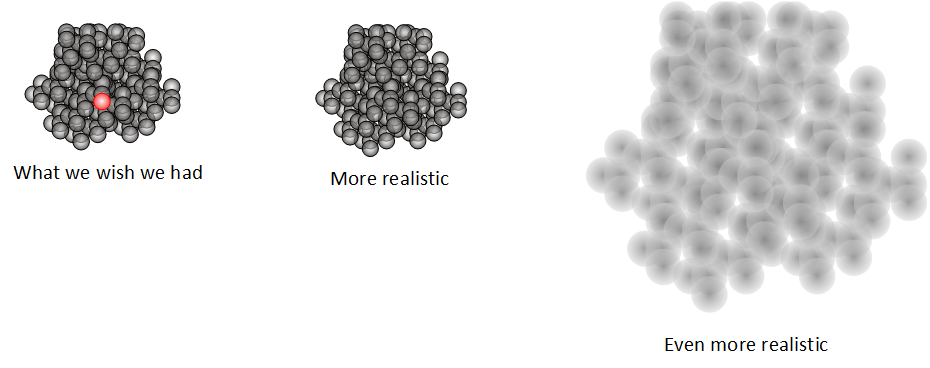
Energy to Move
Next we’ll talk about insulators. You probably know that an insulator can’t conduct any current under normal circumstances – that’s what makes it an insulator. This also applies to our open mechanical switch: the air between the contacts is acting like an insulator.
We can think about how an electron travels based on how much energy it needs to get from here to there. In a wire, that energy is supplied by the voltageVoltage is what gets electrons to flow. It's analogous to water pressure, which gets water to flow. Voltage is measured in units of "volts.", and there are straightforward rules that describe how that electron will move. We can describe this visually using an energy chart (also sometimes called a band diagram, depending on what you’re discussing). These can get super complicated, but we’re not going to take it there. Especially for our wire.
Here’s how to look at this diagram. Left to right shows physical position. Assuming this is a wire, then the left of the chart is the left end of the wire; the right edge of the chart is the right end of the wire. The vertical portion shows how much energy is needed at any position in order for the electron to move from left to right. And we just show a straight line across there because the energy required to move is constant all along the wire.
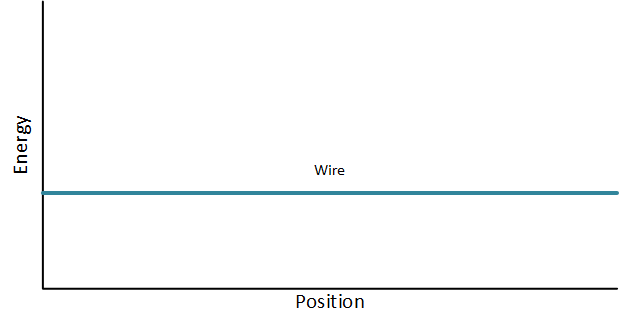
Insulators and Energy Barriers
Now… what happens when we put an insulator in there? Let’s say we create a break in the wire. Now there’s an air gap – which is an insulator. The electronsA fundamental particle found outside atoms. It carries a negative charge. It can move easily in a conducting material, which gives rise to electrical current. can jump that gap – creating a spark – but it takes way more energy to do that. We talked before about needing about 10,000 volts per centimeter of air to make that jump.
We can show this in the energy diagram. Instead of a straight line all along, there’s a big jump where the insulator is. In other words, the electrons don’t need a lot of energy to move in the wire parts, but it takes a lot of energy to get them to jump over this energy barrier. So, if you don’t provide enough energy, then the electrons can’t get over the barrier, and we get no conduction.
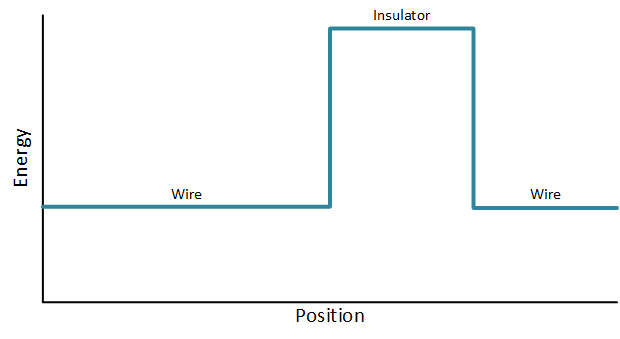
Statistically, you can’t assume that every electron has the same energy. Some will have more, some less. On the diagram below, we show that as red “fuzz.” If that barrier is super high, then you’ve got to summon up a huge push to get over it. If the electrons don’t have that energy, then you get no conduction.
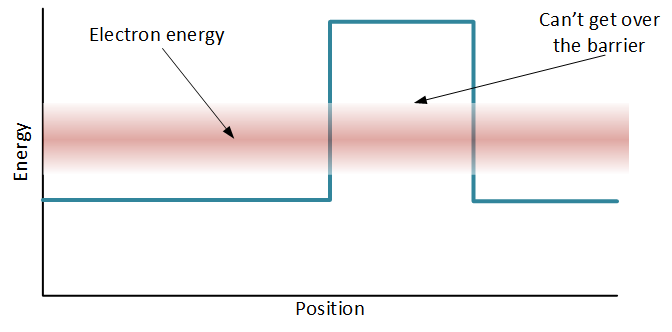
But what if it’s only sorta high compared to the energy of the electrons? Well, then, mostly, you won’t have any conduction. But if, say, the temperature rises, well, that adds energy to all of the electrons.
So, as you add more energy to them all, the ones that already had more energy may actually have enough to jump that barrier. So you get some leakage – and, the more the temperature goes up, the more leakage you get. And it’s not just temperature: any source of energy can cause this.
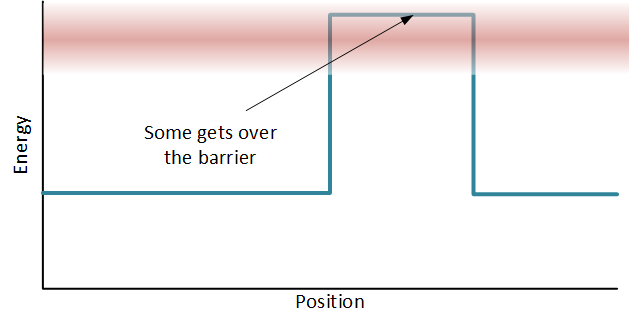
Going Over – or Through – the Barrier
If the energy gets high enough for a lot of electrons to jump over, you get what’s called breakdown – where a sudden rush of current starts. That could be a spark if the insulator is air, but with other insulators – solid ones in particular – you may end up damaging them. Kind of like when you see household plugs that have failed and have scorch marks on them. If you control the energy well enough, however, then you can let some electrons flow without causing damage. We won’t get into it, but this is one mechanism used when storing data in flash memoryA type of memory that can retain its contents even with the power off. Thumb drives use flash memory. cells.
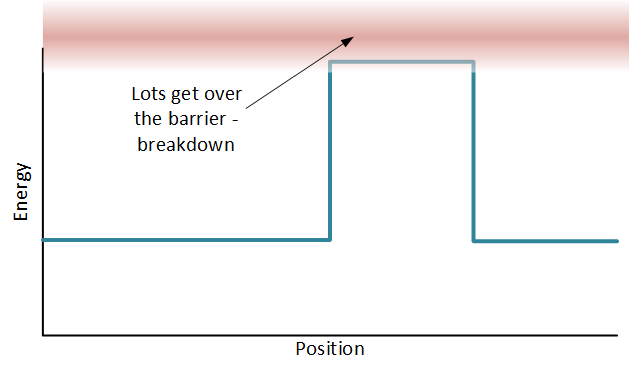
But here’s where it gets weird. You know that thing about not knowing exactly where an electron is? Well, this is going to be a super-oversimplified way of looking at it, but that means that, on this chart, it doesn’t exist at a specific point. It exists somewhere in a fuzzy range. If your insulator is really thick, then this doesn’t matter.
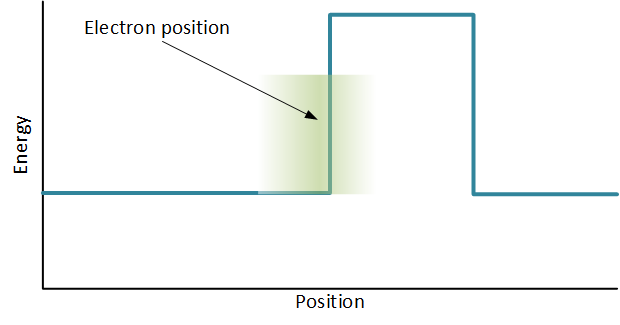
But if the insulator is super thin – similar to the size of the position “fuzziness” – then it means that the electron might actually be on the other side of the barrier.
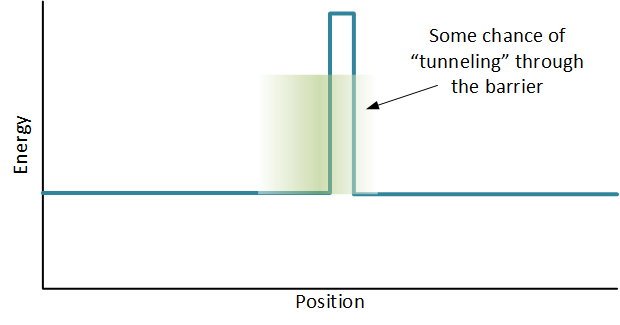
I know this sounds super weird, but what this means is that, if the insulator is thin enough, then an electron can get through it almost as if simply disappearing from one side and appearing on the other, without going over the top (because it doesn’t have enough energy to get over the top). It’s like it’s going right through the insulator. We refer to this as tunnelingA phenomenon where current can flow through a very thin insulator due to quantum effects., and it’s used all over the place, including for flash memory, magnetoresistive RAM (MRAM), and many other places. So this isn’t just a weird idea; it seems to work in real life.
Limiting Current for Lower Energy
What this means is that, just like “off” transistors may not be totally off, insulators, if thin enough, may still let some electrons get through. Not a lot, necessarily; just enough. That’s good in applications where we want to keep powerThe rate of energy consumption. For electricity, it’s measured in watts (W). low. A tunneling junction can literally act like a filter of electrons, letting a few through – enough to do some real work – without opening the flood gates. That helps us to save energy.

Leave a Reply